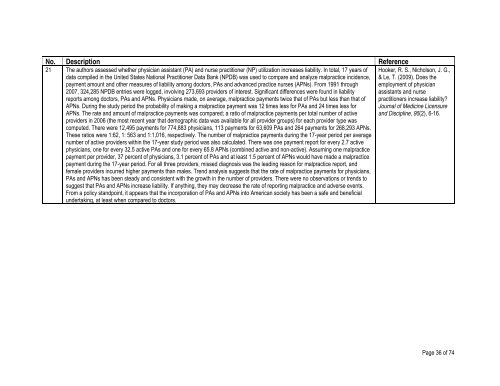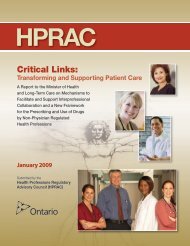Physician Assistants: A Literature Review - Health Professions ...
Physician Assistants: A Literature Review - Health Professions ...
Physician Assistants: A Literature Review - Health Professions ...
- No tags were found...
Create successful ePaper yourself
Turn your PDF publications into a flip-book with our unique Google optimized e-Paper software.
No. Description Reference21 The authors assessed whether physician assistant (PA) and nurse practitioner (NP) utilization increases liability. In total, 17 years ofdata compiled in the United States National Practitioner Data Bank (NPDB) was used to compare and analyze malpractice incidence,payment amount and other measures of liability among doctors, PAs and advanced practice nurses (APNs). From 1991 through2007, 324,285 NPDB entries were logged, involving 273,693 providers of interest. Significant differences were found in liabilityreports among doctors, PAs and APNs. <strong>Physician</strong>s made, on average, malpractice payments twice that of PAs but less than that ofAPNs. During the study period the probability of making a malpractice payment was 12 times less for PAs and 24 times less forAPNs. The rate and amount of malpractice payments was compared; a ratio of malpractice payments per total number of activeproviders in 2006 (the most recent year that demographic data was available for all provider groups) for each provider type wascomputed. There were 12,495 payments for 774,883 physicians, 113 payments for 63,609 PAs and 264 payments for 268,293 APNs.These ratios were 1:62, 1: 563 and 1:1,016, respectively. The number of malpractice payments during the 17-year period per averagenumber of active providers within the 17-year study period was also calculated. There was one payment report for every 2.7 activephysicians, one for every 32.5 active PAs and one for every 65.8 APNs (combined active and non-active). Assuming one malpracticepayment per provider, 37 percent of physicians, 3.1 percent of PAs and at least 1.5 percent of APNs would have made a malpracticepayment during the 17-year period. For all three providers, missed diagnosis was the leading reason for malpractice report, andfemale providers incurred higher payments than males. Trend analysis suggests that the rate of malpractice payments for physicians,PAs and APNs has been steady and consistent with the growth in the number of providers. There were no observations or trends tosuggest that PAs and APNs increase liability. If anything, they may decrease the rate of reporting malpractice and adverse events.From a policy standpoint, it appears that the incorporation of PAs and APNs into American society has been a safe and beneficialundertaking, at least when compared to doctors.Hooker, R. S., Nicholson, J. G.,& Le, T. (2009). Does theemployment of physicianassistants and nursepractitioners increase liability?Journal of Medicine Licensureand Discipline, 95(2), 6-16.Page 36 of 74
















